Dagny Servaes (1894-1961) was a German-Austrian theatre and film actress. She made her first film appearance in 1916 and reached her peak in Ernst Lubitsch' Das Weib des Pharao/The Pharaoh's Wife (1921).
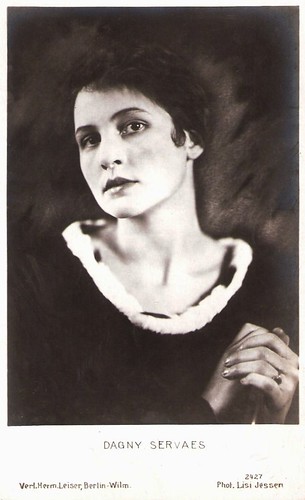
German postcard by Verl. Herm. Leiser, Berlin-Wilm., no. 2427. Photo: Lisi Jessen.
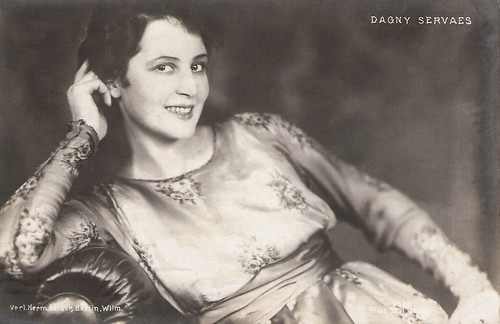
German postcard by Verl. Herm. Leiser, Berlin-Wilm., no. 2429. Photo: Lisi Jessen. Sent by mail in 1918.
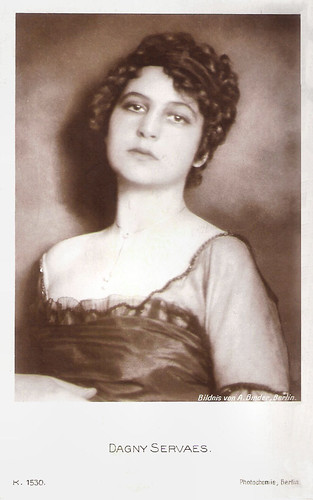
German postcard by Photochemie, Berlin. K. 1530. Photo Alex Binder, Berlin.
Dagny Servaes was born in Berlin in 1894. She was the daughter of author Franz Servaes.
Dagny took acting lessons at the Wiener Akademie für Musik und Darstellende Kunst (Viennese academy for music and performing arts). In 1912 she managed to have an engagement at the Hoftheater in Meiningen, and from 1913 on Servaes played at the reputed Berliner Bühnen as well as at the Deutschen Theater, Lessingtheater and Staatstheater.
From 1916 on, Dagny Servaes played in silent cinema as well, where she soon became a leading actress. Her debut was in the war propaganda film Das Tagebuch des Dr. Hart (1916) by Paul Leni.
That same year she appeared opposite Emil Jannings in Stein unter Steinen/Stone under stones (Felix Basch, 1916).
In the late 1910s she did several films with director Emmerich Hanus, including Aranka und Arauka/Aranka and Arauka (Emmerich Hanus, 1918), Das Geheimnis des Irren/The secret of wandering (Emmerich Hanus, 1919) and Die Nacht der Prüfung/The night of the test (Emmerich Hanus, 1920) with Theodor Loos.
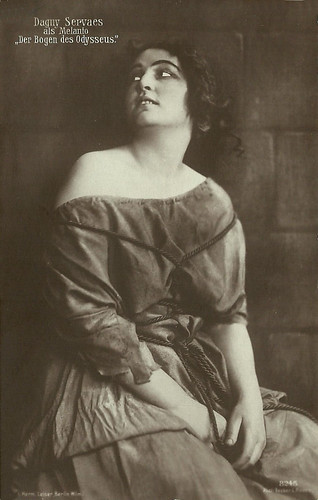
German postcard by Hermann Leiser, Berlin, no. 8245. Photo: Becker & Maass. Publicity still for Der Bogen des Odysseus. Collection: Didier Hanson.
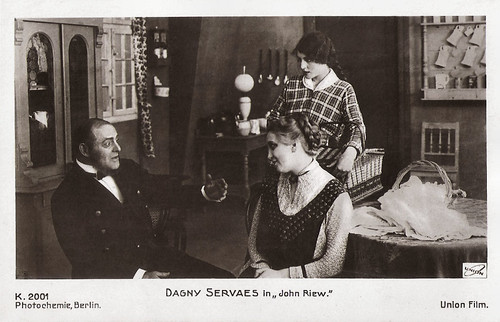
German postcard by Photochemie, Berlin, no. K. 2001. Photo: Union Film. Publicity still for John Riew (Walter Schmidthässler, 1917) with Karl Valentin, Dagny Servaes and Käthe Dorsch.
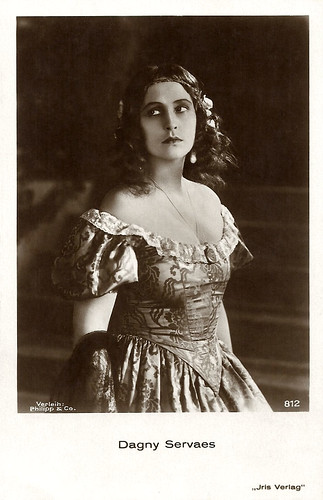
Austrian postcard by Iris Verlag, no. 812. Photo: Verleih Philipp & Co.
Dagny Servaes reached her peak in 1921 with the female lead as a beautiful slave girl in Ernst Lubitsch‘ historical epic Das Weib des Pharao/The Pharaoh’s Wife (Ernst Lubitsch, 1921). The film also starred Emil Jannings as the Pharaoh who falls in love with the slave girl, and Harry Liedtke as Ramphis, her real love interest.
Thomas Staedeli writes at Cyranos: "In 1922 she appeared in Das Weib des Pharao, one of the biggest productions of the year and they predicted her a great career like Pola Negri. But oddly enough her film career got stuck at the beginning, she never played again such an important part as in Das Weib des Pharao."
A memorable lead was the Russian spy Sonia in Oberst Redl/Colonel Redl (Hans Otto Löwenstein, 1924). Sixty years later, Redl’s life was again filmed by Istvan Szabo.
Even though she was celebrated as a star, Servaes’ parts became a bit smaller in the following years, as in Die lachende Grille/The Laughing Cricket (Friedrich Zelnik, 1926) starring Lya Mara, and Die Weber/The Weaver (Friedrich Zelnik, 1927) starring Paul Wegener.
In 1926 she temporarily left the screen and returned to the stage. She joined Max Reinhardt‘s ensemble for a theatre tour across the United States in 1926-1928. In New York she performed in Jedermann/Everyman, Ein Sommernachtstraum/Midsummer Night’s Dream, Dantons Tod/Danton’s Death and Carlo Goldoni‘s Diener zweier Herren/Servant of Two Masters.
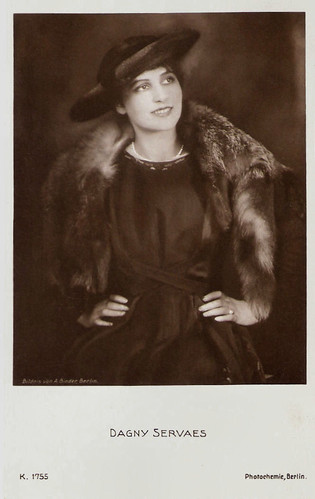
German postcard by Photochemie, Berlin, no. K 1755. Photo: Alex Binder, Berlin.
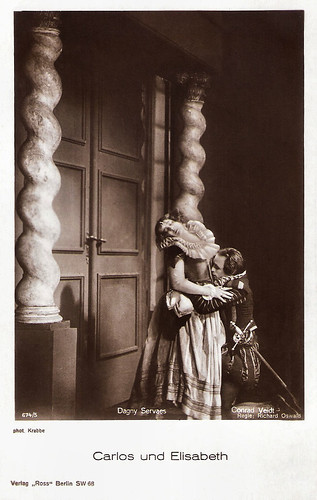
German postcard by Ross Verlag, Berlin, no. 674/5. Photo: Krabbe. Publicity still for Carlos und Elisabeth/Carlos and Elisabeth (Richard Oswald, 1924) with Conrad Veidt.
In 1936 Dagny Servaes established herself in Vienna and played secondary parts in sound films. From 1938 to 1948 she played at the Theater in der Josefstadt and from 1950 on mostly at the Volkstheater. From 1952 on she was part of the ensemble of the Burgtheater.
Until 1959 Servaes played in dozens of German and Austrian films. Among her German films were the UFA comedy Die Töchter ihrer Excellenz/The daughters of Her Excellency (Reinhold Schünzel, 1934) with Käthe von Nagy, Nanon (Herbert Maisch, 1938) with Johannes Heesters, Friedrich Schiller (Herbert Maisch, 1940), and the tearjerker Die goldene Stadt/The Golden City (Veit Harlan, 1942) starring Kristina Söderbaum.
Her Austrian films included Unsterbliche Walzer/Immortal Waltz (E.W. Emo, 1939) as the wife of Johan Strauss Sr. (Paul Hörbiger), Eroica (Walter Kolm-Veltée, 1949) - a biopic on Ludwig von Beethoven (Ewald Balser) - and the Heimat-film Die Regimentstochter/Daughter of the Regiment (George C. Klaren, 1953).
Her last feature film was the romantic drama Der Schandfleck/The disgrace (Herbert B. Fredersdorf, 1956) with Gerlinde Locker.
Dagny Servaes died in Vienna in 1961, her tomb is at the Grinzinger Friedhof. She was married to Erwin Goldarbeiter, an assistant to Max Reinhardt in the 1920s.
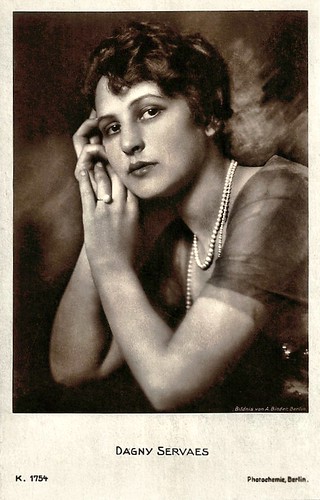
German postcard by Photochemie, Berlin, no. K 1754. Photo: Alex Binder, Berlin.
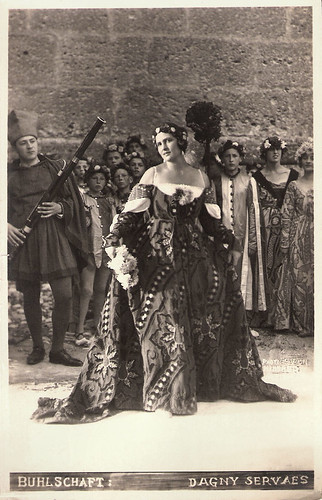
Austrian postcard by Hintner und Traub, Salzburg. Photo: publicity still for the stage play Jedermann (Everyman) by Hugo von Hofmannsthal at the Salzburger Festspiele. She played the part of Buhlschaft from 1926 till 1937.
Sources: Thomas Staedeli (Cyranos), Filmportal.de, Wikipedia (German) and IMDb. Thanks to Helmut Books for the corrections.

German postcard by Verl. Herm. Leiser, Berlin-Wilm., no. 2427. Photo: Lisi Jessen.

German postcard by Verl. Herm. Leiser, Berlin-Wilm., no. 2429. Photo: Lisi Jessen. Sent by mail in 1918.

German postcard by Photochemie, Berlin. K. 1530. Photo Alex Binder, Berlin.
War Propaganda
Dagny Servaes was born in Berlin in 1894. She was the daughter of author Franz Servaes.
Dagny took acting lessons at the Wiener Akademie für Musik und Darstellende Kunst (Viennese academy for music and performing arts). In 1912 she managed to have an engagement at the Hoftheater in Meiningen, and from 1913 on Servaes played at the reputed Berliner Bühnen as well as at the Deutschen Theater, Lessingtheater and Staatstheater.
From 1916 on, Dagny Servaes played in silent cinema as well, where she soon became a leading actress. Her debut was in the war propaganda film Das Tagebuch des Dr. Hart (1916) by Paul Leni.
That same year she appeared opposite Emil Jannings in Stein unter Steinen/Stone under stones (Felix Basch, 1916).
In the late 1910s she did several films with director Emmerich Hanus, including Aranka und Arauka/Aranka and Arauka (Emmerich Hanus, 1918), Das Geheimnis des Irren/The secret of wandering (Emmerich Hanus, 1919) and Die Nacht der Prüfung/The night of the test (Emmerich Hanus, 1920) with Theodor Loos.

German postcard by Hermann Leiser, Berlin, no. 8245. Photo: Becker & Maass. Publicity still for Der Bogen des Odysseus. Collection: Didier Hanson.

German postcard by Photochemie, Berlin, no. K. 2001. Photo: Union Film. Publicity still for John Riew (Walter Schmidthässler, 1917) with Karl Valentin, Dagny Servaes and Käthe Dorsch.

Austrian postcard by Iris Verlag, no. 812. Photo: Verleih Philipp & Co.
Lubitsch
Dagny Servaes reached her peak in 1921 with the female lead as a beautiful slave girl in Ernst Lubitsch‘ historical epic Das Weib des Pharao/The Pharaoh’s Wife (Ernst Lubitsch, 1921). The film also starred Emil Jannings as the Pharaoh who falls in love with the slave girl, and Harry Liedtke as Ramphis, her real love interest.
Thomas Staedeli writes at Cyranos: "In 1922 she appeared in Das Weib des Pharao, one of the biggest productions of the year and they predicted her a great career like Pola Negri. But oddly enough her film career got stuck at the beginning, she never played again such an important part as in Das Weib des Pharao."
A memorable lead was the Russian spy Sonia in Oberst Redl/Colonel Redl (Hans Otto Löwenstein, 1924). Sixty years later, Redl’s life was again filmed by Istvan Szabo.
Even though she was celebrated as a star, Servaes’ parts became a bit smaller in the following years, as in Die lachende Grille/The Laughing Cricket (Friedrich Zelnik, 1926) starring Lya Mara, and Die Weber/The Weaver (Friedrich Zelnik, 1927) starring Paul Wegener.
In 1926 she temporarily left the screen and returned to the stage. She joined Max Reinhardt‘s ensemble for a theatre tour across the United States in 1926-1928. In New York she performed in Jedermann/Everyman, Ein Sommernachtstraum/Midsummer Night’s Dream, Dantons Tod/Danton’s Death and Carlo Goldoni‘s Diener zweier Herren/Servant of Two Masters.

German postcard by Photochemie, Berlin, no. K 1755. Photo: Alex Binder, Berlin.

German postcard by Ross Verlag, Berlin, no. 674/5. Photo: Krabbe. Publicity still for Carlos und Elisabeth/Carlos and Elisabeth (Richard Oswald, 1924) with Conrad Veidt.
Der Jozefstadt
In 1936 Dagny Servaes established herself in Vienna and played secondary parts in sound films. From 1938 to 1948 she played at the Theater in der Josefstadt and from 1950 on mostly at the Volkstheater. From 1952 on she was part of the ensemble of the Burgtheater.
Until 1959 Servaes played in dozens of German and Austrian films. Among her German films were the UFA comedy Die Töchter ihrer Excellenz/The daughters of Her Excellency (Reinhold Schünzel, 1934) with Käthe von Nagy, Nanon (Herbert Maisch, 1938) with Johannes Heesters, Friedrich Schiller (Herbert Maisch, 1940), and the tearjerker Die goldene Stadt/The Golden City (Veit Harlan, 1942) starring Kristina Söderbaum.
Her Austrian films included Unsterbliche Walzer/Immortal Waltz (E.W. Emo, 1939) as the wife of Johan Strauss Sr. (Paul Hörbiger), Eroica (Walter Kolm-Veltée, 1949) - a biopic on Ludwig von Beethoven (Ewald Balser) - and the Heimat-film Die Regimentstochter/Daughter of the Regiment (George C. Klaren, 1953).
Her last feature film was the romantic drama Der Schandfleck/The disgrace (Herbert B. Fredersdorf, 1956) with Gerlinde Locker.
Dagny Servaes died in Vienna in 1961, her tomb is at the Grinzinger Friedhof. She was married to Erwin Goldarbeiter, an assistant to Max Reinhardt in the 1920s.

German postcard by Photochemie, Berlin, no. K 1754. Photo: Alex Binder, Berlin.

Austrian postcard by Hintner und Traub, Salzburg. Photo: publicity still for the stage play Jedermann (Everyman) by Hugo von Hofmannsthal at the Salzburger Festspiele. She played the part of Buhlschaft from 1926 till 1937.
Sources: Thomas Staedeli (Cyranos), Filmportal.de, Wikipedia (German) and IMDb. Thanks to Helmut Books for the corrections.
4 comments:
Since her father's name was Servaes, she could not possibly have been born with the name Goldarbeiter. Fact is, she married Erwin Goldarbeiter in the 1920s (he was an assistant to Max Reinhardt).
Thanks, Helmut. We've updated the information.
Due to the fact that Erwin Goldarbeiter was Jewish, the Reichskammer of the Third Reich did not allow her to perform anymore, until they decided to divorce.
In the late 30's the team around Max Reinhardt got into trouble due to the fact that most members of the theatre group were Jewish. In the meantime Erwin Goldarbeiter became assistant to Egon Friedell (1878–1938), a Jewish writer and artist in Vienna. When the secret police of the Third Reich came to arrest Friedell, Friedell jumped through the glass of his appartment and died on the pavement at the front door of his appartment due to the impact. Friedell's girlfriend managed to give the manuscript of Friedell's book "Kulturgeschichte des Altertums" to Erwin Goldarbeiter, who brought it to Norway where it was published.
Erwin Goldarbeiter managed to escape to the USA after his trip to Norway. Part of the team of Max Reinhardt managed to make this escape as well and they got in contact again in New York. Erwin Goldarbeiter becomes a citizen of the USA after naturalization
After the death of Max Reinhardt in New York during the war, Erwin Goldarbeiter moved to California.He got married with Martha Fallon, born Otto and changed his name officially to Godart.
After the war he is active in Germany, Austria and the USA in the theatre and the movies. All this time he kept contact with Dagny Servaes and their daughter Evi.
Thanks for this interesting additional information.
Post a Comment